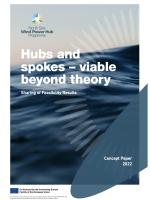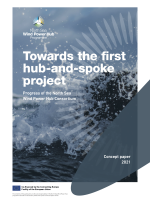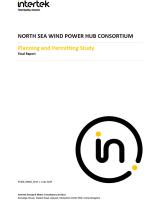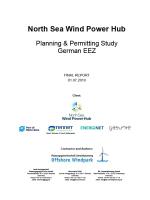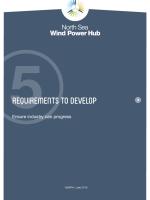Hubs and spokes – viable beyond theory
Sharing of feasibility results 2021 to 2022 (November 2022)
The European Union and the member states have set ambitious targets for the build-out of sustainable energy. Governments across the continent point to offshore wind to play a key role, not least from the windy North Sea. Offshore wind capacity targets have been confirmed at 65 GW by 2030 and 150 GW by 2050, signifying the acceleration of renewable electricity and hydrogen developments. Similarly, a joint electrolysis capacity target is set at 20 GW for 2030.
A vision of multiple connected offshore energy projects and hubs for electricity and hydrogen transport has been gaining ground politically, as has the importance of cross-border cooperation and interconnection.
With this feasibility report, we present a range of findings of crucial importance to realising these political goals.
In the feasibility phase of the NSWPH project, we introduced the distributed hub concept, which includes three offshore energy hubs in Denmark, the Netherlands, and Germany. This is a bold step to building the interconnected North Sea electricity and hydrogen infrastructure. This hub-and-spoke-model allows for an internationally coordinated and modular buildout that achieves three vital tasks that the future green power plant in the North Sea must be able to perform: collect, connect, and convert the power from the North Sea.
In the feasibility phase, we found answers to how we can develop the North Sea Wind Power Hub project. This includes detailed technical analyses of hub foundations, electrical and hydrogen infrastructure, and power-to-gas, as well as energy system studies and policy and market assessments. In addition, we further develop the cost-benefit analysis framework for hub-and-spoke concepts and successfully apply this to possible/likely configurations. These findings are presented here.
The NSWPH project has moved from an ambitious novel concept to receiving concrete political buy-in. In that sense, the landscape has changed completely over the last few years as there are concrete national projects underway following the concept. We are proud to have contributed to the changing landscape of North Sea offshore wind development through continuous knowledge development and sharing.
Collect, Connect, Convert
The North Sea Wind Power Hub achieves three vital tasks that the future green powerplant of the North Sea must be able to lift:
- Collect vast amounts of offshore wind power generated at wind farms and energy hubs in the North Sea at a few centralised locations.
- Connect these hubs in a flexible network that spans the North Sea and can supply power deep into the European mainland to supply millions of consumers with green energy.
- Convert surplus electricity to hydrogen to expand the uses of the green power and reduce CO2 emissions from heavy industry, transport and more.
